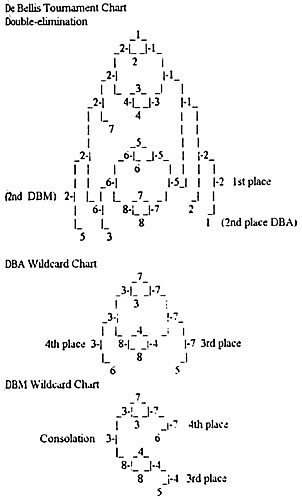I would like to present a tournament format for both De Bellis games. The Double- elimination system works very well. Since these games conclude in a definite victory, players can compete without using a point system that inordinately awards players large scores for defeating unskillful or unlucky competitors, thereby allowing them to win a tournament without having won the most games. The drawback to the elimination system is the limited number of games played by those knocked out in the early rounds. To offset this, I propose a wildcard pool in which those players eliminated from the main competition can still play and compete for third and fourth positions. While these spots may receive no award within a tournament, should a championship be played, they could be valuable.
Included is a chart detailing a Double-elimination pool with a wildcard pool following. By following the win-loss progression, players can see how advancement and transference functions. In every pair it is always the top that wins, except in the first DBA challenge match where #2 wins so the two can go on to an additional round. If there are 9-13 players, the first few knocked out can form a second tourney. The first group will place 1-4. the second will have a wildcard pool for their tourney. If there are 14-16 players, two tourneys can be run. If there is an odd number of competitors, a by is placed in a slot (no two byes should end together in the first two rounds).
Players with a by automatically advance, but are not credited a victory. With this format, a DBA tournament will take less than four hours.
An abbreviated format can be used for DBM. Rather than continuing to play with all but one player has lost two games, play is stopped at the conclusion of the last battle on the loss side of the chart. In this way the winner is undefeated, second place has one defeat. third and fourdi go to the players who win the wildcard pools. Since a 300-400 point battle can be concluded ui about two hours, this tournament could easily be done in a day with all players playing 4-5 games (except the winner who obviously doesn't need the practice).
Lastly, for DBA, organizers may opt to supply players with historically matched pairs. Four pairs would allow all players to play a different army in each gain.-. This accomplishes two things. First, players are exposed to a wider variety of tactical circumstances, thereby challenging their generalship. Secondly. it keeps players from competing with elephant armies (which I pointed out in a previous article are powerful enough in DBA to count as two elements). Or, they may wish to have players switch sides and fight their battle twice, high point scorer wins. (Thi would certainly even out everyone.) Of course. if they tied, you might have to do something like roll a die to determine the winner, or a face-off match with identical armies (which is always the toughest way to play'), Some players may wish to use DBM rides with 100 point armies including a free general and camp. (if using the matched pairs, organizers should also keep track of army victories to make certain no particular army in a pair is doing more of the winning than the players. No more than a 3:2 ratio should occur.) Some players may wish to use DBM rules with 100 point armies including a free general and camp.
Players may wish to compete in a Multi-tournament Championship, scoring points for each win/place/show in each tournament, leading to an over-all Champion. Scoring would be as follows:
- Pos : Pts
1st : 5
2nd : 3
3rd : 2
4th : 1
They may also keep track of player's win-loss records as a means of rating their skill, thereby making certain the best players are not matched up at the beginning of a tourney. Good gaming!

Back to Saga #47 Table of Contents
Back to Saga List of Issues
Back to MagWeb Master Magazine List
© Copyright 1995 by Terry Gore
This article appears in MagWeb (Magazine Web) on the Internet World Wide Web. Other military history articles and gaming articles are available at http://www.magweb.com